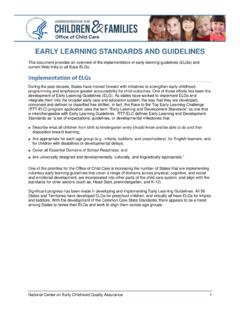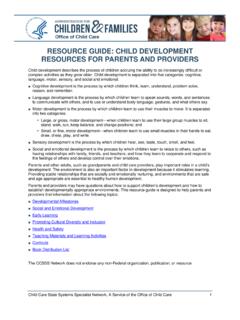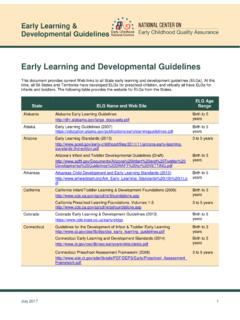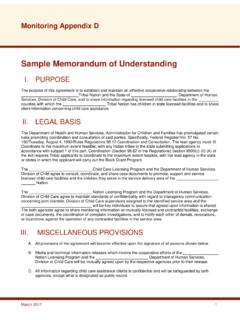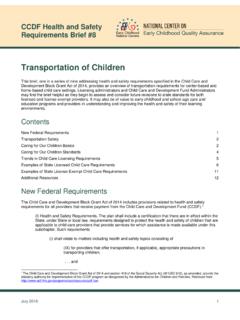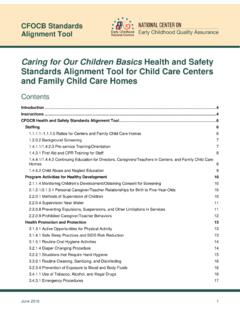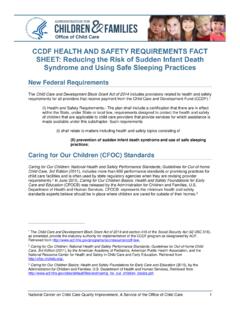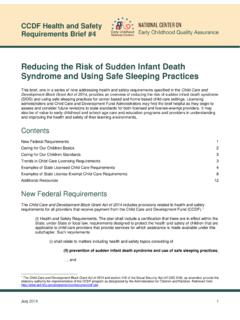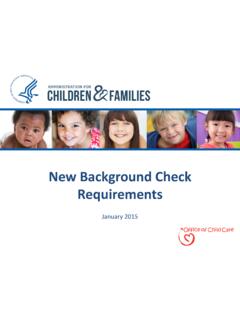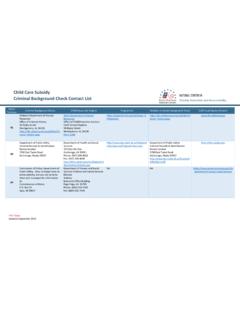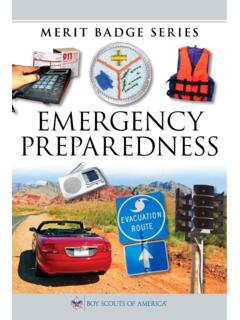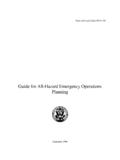Transcription of Emergency Preparedness and Child Care Facilities …
1 Emergency Preparedness AND Child CARE FACILITY LOCKDOWNS: EXAMPLES OF LICENSING REGULATIONS, PROCEDURES, AND TRAININGS Child care facility lockdown licensing regulations, requirements, definitions, and procedures vary from State to State. States also vary in the trainings they offer programs related to Child care facility lockdowns and Emergency Preparedness . This document provides examples of licensing regulations and highlights procedures from State Emergency Preparedness guides designed to help Child care programs create plans. It also highlights trainings offered by States designed to help Child care programs develop Emergency Preparedness plans. Selected State Examples: Licensing Regulations The Child Care Systems Specialist Network reviewed the State licensing regulations for Child care center and family Child care programs to determine: 1) how States define lockdown or shelter-in - place , since some States consider these as separate actions while others view lockdown as a subset of shelter-in - place ; and 2) whether States provide procedures on how lockdowns or shelter-in - place will occur.
2 The following are excerpts from State Child care licensing regulations about ensuring the physical safety of children during an Emergency through the provision of facility lockdowns and shelter-in - place . This information was compiled from the Child care licensing regulations posted on the National Resource Center for Health and Safety in Child Care and Early Education s (NRC) Web site at Lockdown Colorado Volume of Child Care Facility Licensing (12 CCR 2509-8) in Code of Colorado Regulations states: Definitions and Types of Family Child Care Homes Definitions Lockdown drill means a drill in which the occupants of a building are restricted to the interior of the building and the building is secured. Administrative Records and Reports C. The home must have a written plan and Emergency response procedures that explain, at minimum, the life saving procedures that will be followed, and how the home will function during a fire, severe weather, lockdown, reverse evacuation, or shelter-in - place Emergency situation.
3 The plan must include, but not be limited to: 1. Prompt notification of parents or guardians. 2. When local authorities will be notified. 3. How Emergency transportation will be provided. Statement of Policies Child Care State Systems Specialist Network, A Service of the Office of Child Care 1 Emergency Preparedness and Child Care Facility Lockdowns November 2014 B. The written policies and procedures must be developed, implemented and followed, which includes all updates, changes, and must include at a minimum the following information: 29. Emergency response procedures that explain, at a minimum, the life saving procedure that will be followed and how the home will function during a fire, severe weather, lockdown, reverse evacuation, or shelter-in - place Emergency situation. Communication, Emergency , and Security Procedures B.
4 Emergency Response and Drill Procedures All drills must be held at varying times and all adults and children present in the home must participate in all drills. Fire drills must be conducted monthly. The following drills must be held a minimum of two (2) times per year: 1. Severe weather; and, 2. Lockdown; and, 3. Reverse evacuation; and, 4. Shelter-in - place . Louisiana* Title 67. Social Services in Louisiana Administrative Code states: Subpart 21 Child Care Licensing, Chapter 73. Day Care Centers Subchapter A. Licensing Class A Regulations for Child Care Centers 7328. Emergency Preparedness and Evacuation Planning B. The multi-hazard Emergency and evacuation plan shall include lock down procedures for situations that may result in harm to persons inside the Child care center, including but not limited to a shooting, hostage incident, intruder, trespassing, disturbance, or any situation deemed harmful at the discretion of the director or public safety personnel.
5 The director shall announce the lock down over the public address system or other designated system. The alert may be made using a pre-selected code word. In a lock down situation, all children shall be kept in classrooms or other designated safe locations that are away from the danger. Staff members shall account for children and ensure that no one leaves the classroom/safe area. Staff shall secure center entrances and ensure that no unauthorized individual leaves or enters the center. 1. Staff and children shall remain in the classroom/safe area, locking the classroom door, turning off the lights, and covering the windows. Staff shall encourage children to get under tables, behind cabinets, etc., and, if possible, engage in quiet story time activities with the children until all clear is announced. 2.
6 Parent or authorized representative shall be notified of a lock down situation at the center no later than at the time of the Child s release on the date of the occurrence. * Licensing language was taken from the Louisiana Administrative Code available on the Louisiana State Web site, and not from the licensing regulations highlighted in the NRC Web site. This resource is available at Child Care State Systems Specialist Network, A Service of the Office of Child Care 2 Emergency Preparedness and Child Care Facility Lockdowns November 2014 New Jersey Chapter 122: Manual of Requirements for Child Care Centers in New Jersey Administrative Code states: 10 Physical plant requirements for all centers (l) Emergency procedure requirements are as follows: 1.
7 The center shall prepare written Emergency procedures delineating: ix. Procedures for ensuring children s safety and communicating with parents in the event of evacuation, lockdown, natural or civil disaster and other emergencies. The procedures shall indicate: (1) The plan for informing parents of their children s whereabouts; and (2) The local law enforcement agency or Emergency management office that has been notified of the center s identifying information, as specified in (k)3 below. 2. The Emergency procedures shall be posted in a prominent location on every floor within the center. 3. The center shall ensure that the appropriate local law enforcement agency or Emergency management office is notified of: i. The center s name and location; ii. The number and ages of children enrolled; iii. The number of staff; iv.
8 The need for Emergency transportation; v. The location to which children will be evacuated; vi. The plan for a lockdown; and vii. The plan for reuniting children with their parents. Washington Chapter 170-296 WAC Licensed Family Home Child Care Standards, in Washington Administrative Code states: Chapter 170-296A WAC (Last Update: 7/28/14) Licensed Family Home Child Care Standards 170-296A-2850 Disaster plan. (1) The licensee must have a written disaster plan for emergencies other than fire. The plan must be reviewed annually and updated as needed. (2) The written disaster plan must cover at minimum the following: (a) For disasters that may require evacuation: (i) How the licensee and staff will evacuate all children, especially those who cannot walk. (ii) What to take when evacuating the children, including: (A) First aid kit; (B) Child medication records; and Child Care State Systems Specialist Network, A Service of the Office of Child Care 3 Emergency Preparedness and Child Care Facility Lockdowns November 2014 (C) If applicable, individual children's medication; (iii) Where to go; and (iv) How the licensee and staff will account for all of the children in attendance.
9 (b) Earthquake procedures including: (i) What the licensee and staff will do during an earthquake; (ii) How the licensee and staff will account for all of the children in attendance; and (iii) After an earthquake, how the licensee will assess whether the licensed space is safe for the children; (c) Lockdown of the facility or shelter-in - place , including: (i) How doors and windows will be secured if needed; and (ii) Where children will stay safely inside the facility; and (d) How parents and guardians will be contacted after the Emergency situation is over. (3) The licensee must keep on the premises a three-day supply of food, water, and medications required by individual children for use in a disaster, lockdown, or shelter-in - place incident. (4) As used in this section, "lockdown" or "shelter-in - place " means to remain inside the family home Child care when police or an official Emergency response agency notifies the licensee or primary staff person in charge that it is unsafe to leave the facility or be outdoors during an Emergency situation.
10 Shelter-in- place Delaware Rules for Family Child Care Homes states: Emergency Planning 229. The Licensee shall have a written Emergency plan describing procedures for both natural and man-made disasters for such situations as a fire, flood, earthquake, extreme weather conditions, power failure or utility disruptions, chemical or toxic spills, bomb threat or terrorist attack. A. The Emergency plan shall include procedures for training household member(s) and the Substitute, when applicable, about specific responsibilities during a disaster, accounting for all children, relocation process (if appropriate) and contacting appropriate Emergency response agencies and parent(s)/guardian(s). 230. The Licensee shall have a posted written plan or diagram showing how the Family Child Care Home will be evacuated during an Emergency .
